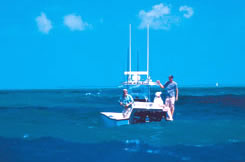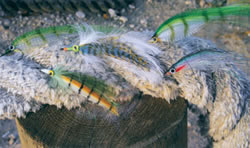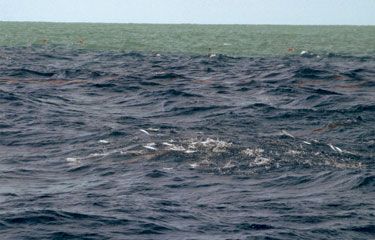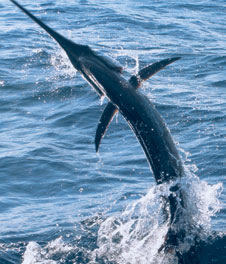January 17, 2014
By Pat Ford
Set your sights on fly fishing for Florida sailfish.

When a sharp color change sets up off Key West, it's possible to sight-cast to sailfish. |
Fly fishing for sailfish is easy. Hop on a jet and head to the Pacific side of Central America, and book a competent crew out of Guatemala, Panama, Costa Rica or Mexico. Can it really be that easy? Yes it is, now that fly fishing is no longer an oddity in those parts.
Want to raise the bar and do that deal close to home? Well, you can, though taking an Atlantic sailfish on fly off Florida is still considered an extraordinary feat, for a number of reasons.
Atlantic sails are smaller, but infinitely smarter. They can be teased up with a hookless bait, but usually only stay on the scene long enough to make one pass at the fly. In other words, everything has to go perfectly. Pacifics, on the other hand, will sit behind the boat and chew on a rubber squid forever.
Billy Pate moved to the Keys in the late '60s primarily due to his love of tarpon. During his second year there, he realized that tarpon were few and far between in winter, so eventually he headed offshore of Islamorada for sails. It wasn't too long before he decided to try to catch one on a fly rod—a feat that had only been accomplished by three anglers, J. Lee Cuddy, Ray Simon and Gil Drake, prior to 1970.

Ballyhoo patterned pilchard |
Pate eventually rigged out a 22-foot Mako with a tower that worked pretty well as long as the seas were calm. He used a hookless dead mullet as a teaser and eventually caught a fair number of sails on a fly off Islamorada, but he was the only one willing to put in the time to hook one fish every six trips. Then, everyone discovered Cozumel, Mexico, and to say the least, the development of fly fishing for sails in Florida came to a halt. Nobody bothered with Florida, where you might get two shots a day. In Cozumel, you could expect 15 to 20 fly shots on a good day.
I fished a lot with Miami Rod and Reel Club member Frank Inscho in those days. He was a big-boat enthusiast and my specialty was small boats and light tackle so we taught each other. Frank kept his boat in Stuart during the winter and we would hop up there every so often to try to catch a sail on fly. We hooked a few over the years, but didn't land any. It was pretty frustrating to stand around with a fly rod in hand while other boats were fighting fish right next to you.
The same holds true today, but techniques have been developed to match Florida's unique sailfishing conditions.

A reefline ruckus. |
If you want to try to catch a sail on fly in Florida you have several options. Out of Stuart or Fort Pierce you can still troll a dead ballyhoo and tease up several fish a day. Actually, for a few days each year, sailfishing off Fort Pierce gets as good as Cozumel, but there's just no way to predict when those days will occur. You have to have a lot of time to kill or be very lucky. The trolling/teasing technique is the same as in Costa Rica or Guatamala, but again, Atlantic sails lose interest very quickly. The guy doing the teasing is far more important than the guy holding the fly rod. The more excited the fish, the better the angler's chances of a solid hookup. In addition, it's easier to entice a sail from a dead bait to a fly than it is from a live bait to a fly.
However, the Palm Beach to Fort Pierce stretch can host pods of sails “balling” schools of migrating baitfish. I eventually hooked up with Rod and Reel Club member Ron Hamlin, who was running a private boat out of Palm Beach. He'd call when the sailfishing was hot and I would drop whatever I was doing and get up there the very next morning. Well, it worked. Hamlin called on February 3rd when sailfish were balling bait like no one's business. The next morning I was at his dock at daylight but by 1 p.m. we hadn't seen a fish. Then Hamlin spotted some birds and we hit the jackpot. I hooked four sails on fly that day and boated a 51 1/2-pound fish that still stands as the Florida state record. But, in spite of the ideal conditions that day, getting bites was not easy. The sails would circle the bait until it was bunched up in a giant ball. Then a fish would crash through the ball, stunning any number of the minnows with its bill. The ball would then disintegrate and the pod of sails would swim around leisurely eating the stunned baitfish. Right after the sails crashed the bait, I cast a fly that matched the size and shape of the bait into the melee and did not move it at all. The four fish that I hooked just swam up and ate the dead-drifting baitfish fly. I only managed to keep one of those beauties on the hook, but I haven't had that kind of success since in Florida waters.

Atlantic sails are famous for aerial antics, fighting as much above water as be |
Out of Miami, sailfish are a bit more scarce, and much fussier. Most Miami and Upper Keys sails are caught on live blue runners or pilchards fished under kites. I know many anglers who have tried to tease the sails into fly-casting range by bringing in the kite, but it just doesn't seem to work very well. You don't have enough control of the bait and the sail either catches the bait and eats it, or simply loses interest when the baitfish “disappears into the sky.” The only person I know who has caught a sail on fly in Miami is Bill Lindsay and that was a dozen years ago or so. Pate caught one at the Fort Lauderdale Billfish Tournament last November, winning the tournament's first-ever fly division prize.
In the Lower Keys the odds improve, but the technique changes. Off Key West, for example, you can't slow-troll a hookless live bait for 10 minutes without a barracuda or mackerel chewing it up. The same holds for dead baits. There are just too many other kinds of fish around for effective teasing. Nevertheless, Capt. R.T. Trosset has caught several sails on fly and has guided his anglers to several more by anchoring up and chumming with live bait. Trossett runs a 31-foot open fisherman out of Key West and a typical winter fishing.
g day starts with loading up the baitwell with several thousand pilchards and then live-chumming off the reef. This aquatic buffet brings tuna, kings, wahoo and often sailfish right to the boat. He has found that the most effective flyrod technique is to throw a pilchard-size streamer with a clear intermediate fly line.
Actually, this style of chumming paid off for South Florida angler Mitch Howell while fishing west of the Dry Tortugas with Capt. Rob Hammer, who knows this area's wrecks, rocks and humps intimately. Hammer and Howell were live-chumming a wreck in 160 feet of water about 20 miles west of the Tortugas when three sails came up, hot as can be. A few more pilchards just added to the excitement. When Howell cast a Pilchard Special fly, a fish hit it going away, just like a good sailfish is supposed to. The fly stuck squarely in the corner of the sail's jaw and 30 minutes later Howell had his first sail on fly. Fly fishers out of Key West also sight-cast to cruising sails along the color change, which can be surprisingly effective. Sometime in March and April, cobia, big jacks and sailfish migrate along the color change for about two weeks. You need a boat with a tower and you simply idle along looking for fish. The rougher it is, the better the fishing because you can maneuver within casting range without spooking the fish which seem to attack anything they see. The tradeoff is fly casting into a 25-knot wind from the bow of a rocking boat. A word of advice: Bring a big laundry basket or a commercially made flyline container. During a trip last spring, the color-change sailfish run was on and I managed to put the fly in front of three fish, all of which ate, but none of which stayed hooked very long.
This brings us to another problem: Sailfish are almost impossible to hook when they are swimming toward you. If they swim up behind your fly and eat it, any attempt at setting the hook will either pull the fly out of its mouth or stick it in the bill, which is very temporary at best. The trick is to cast the fly away from and beyond the sail so that it turns and hits the fly going away, resulting in a hookup in the corner of the mouth. This works great with a teased fish that is spinning around and looking for the food that just escaped. Nine times in ten, a cruising sail or one happily chewing on pilchards in a chum line will come up behind the fly and hit it coming at you.

Ballyhoo pattern pilchard flies. |
Trossett caught his personal best sailfish casting at the color change. He was on a busman's holiday with his son when they spotted the sail. It was oblivious to the boat and ate the fly three times before managing to get itself hooked. Trossett claims it was at least 65 pounds (and repeats the story every time he sees me) but I still haven't seen any photos so I'm not about to concede my state record just yet!
Islamorada has become the epicenter for fly fishing for sails in the Keys. There are lots of sails there in December and January and only limited numbers of pesky 'cuda and mackerel. Quite frequently, sailfish are found up on the reef in clear water busting ballyhoo, which is the teaser bait of choice. Islamorada resident Sandy Moret caught the sail-on-fly bug a half-dozen years ago and has been developing interest in it. He founded the annual two-day Islamorada Invitational Fly Rod Sailfish Tournament, now in its sixth year. It draws an average of 15 boats, and a few sails are normally caught. As expected, the Islamorada boats start out with a baitwell full of live ballyhoo. Baits are rigged carefully on light wire without a hook and are slow-trolled about 50 feet behind the boat on spinning rods. A spinning rod is preferred also to cast to a sail spotted chasing bait on the reef. You should have only two teasers in the wake on flatlines at a time, and the baits have to be changed out once they stop swimming under their own power.
Standard gear is a 10- to 12-weight fly rod and a 400-grain sinking tip line. You don't have to cast far, but the cast has to put the fly in position so the fish will hit it going away, if possible. You are usually so excited that you can't do much more than flop the fly into the water and hope you're not standing on your fly line. Again, a line tamer is highly recommended.
As for Florida sailfish flies, Keys fish seem to like a pilchard or a ballyhoo pattern. When the teaser is jerked away, the sail is going to be looking for the baitfish that just escaped, not three pounds of white feathers that anglers toss at Pacific sails. I swear by the Pilchard Special, originated by Miami guide and fly tyer Chris Dean, and also have hooked up with a ballyhoo imitation made of synthetic Super Hair that is 6 inches long overall. There's debate whether single-hook or double-hook flies are best. I have done well with both types.

Natural ballyhoo teaser can be used to lure sails in close. |
Keys charter captain Randy Towe recently overheard my discussions with Sandy Moret and Billy Pate about sails on fly and offered to take us out to see if we could actually hook one. Towe's 45-foot walkaround sportfisherman of his own design is very conducive to offshore fly fishing. It was an education to watch Towe's crew at work. First stop was the edge of the reef to catch ballyhoo. Three throws of the net put three dozen 'hoos in the baitwell and ten minutes later we were fishing. Towe's teasing rig was impressive. He put three ballyhoo on one rod and a single bait on another. Instead of hooks, thin copper wire was inserted under and through the bait's lower jaw and then wrapped around the bill and line. I was amazed at how long the baits tolerated this rig. They seemed to do fine until something started chewing on them. You couldn't use this setup in Key West, but it sure worked well in the Middle Keys.
We slow-trolled the teasers by bumping the engines in and out of gear. A week's worth of north winds had activated the sails, so he didn't have to wait long for the first fish to come into the daisy chain teaser. One mate brought in the single teaser, but kept it ready in case the sail lost interest. The daisy chain was never more than 60 feet behind the boat so it was just seconds before the sail was lured into casting range.
Billy Pate and I have been friends for a few decades, but I'd never actually fished for sails with him. His fly rod looked older than either of the mates. It was the first graphite 12-weight produced by Fenwick, but it still worked! But then again, why wouldn't it? He used a sinking shooting head attached to 50 yards of 50-pound hi-vis mono. Pate made one back cast and then shot the fly a few yards to the right and beyond the sailfish. The mate jerked the teasers out of the water, the fish turned, and then calmly swam over and stared at Pate's fly. Then it casually swam away, obviously not impressed by Pate's credentials. We had two more fish come up on the teasers that day, but they had little interest in the baits and no interest whatsoever in a fly.

This is what prime sailfish conditions look like along the Florida Keys. |
Everything has to go perfectly if you hope to tease sails with live bait. You need the right conditions, usually a chilly northeast wind, and the “right” fish, that is, one that's either very hungry or very stupid. And when you put it all together, as anyone who has hooked a sail on fly will tell you, it's probably the most exciting and intense flyrod fishing of all.
If things go right, you're in for the time of your life if you can just manage to stay calm and get the fly out of the boat.
FS
Originally Published Florida Sportsman Dec. 2005
Click Here to Have Florida Sportsman Magazine Delivered to Your Home
